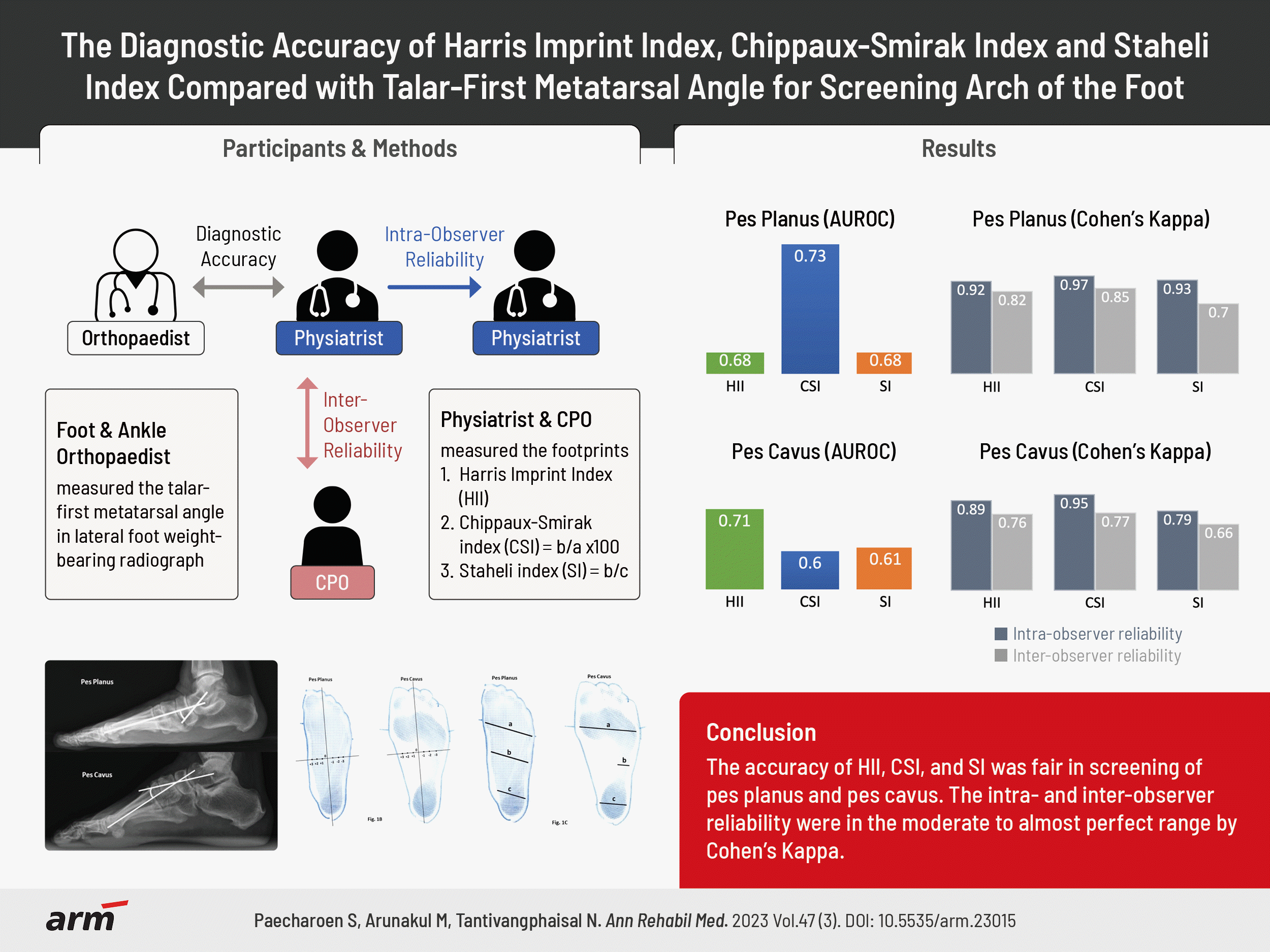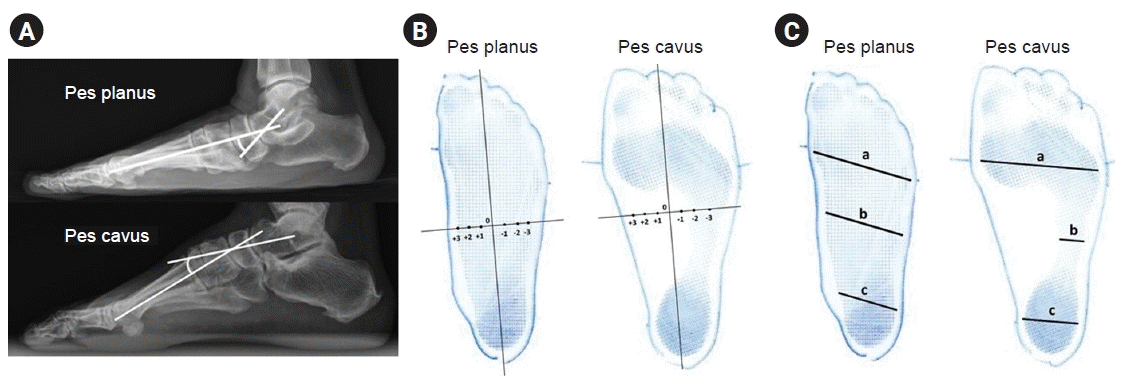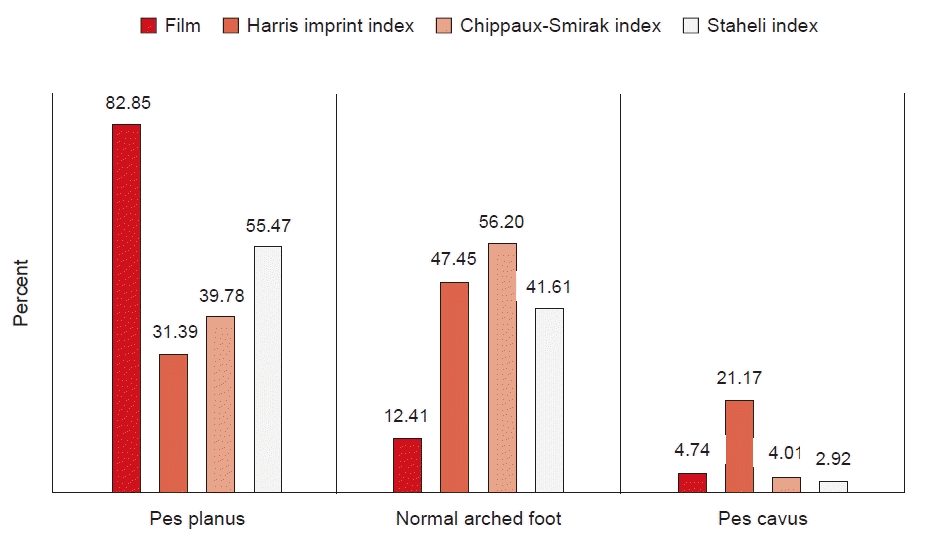1. Tong JW, Kong PW. Association between foot type and lower extremity injuries: systematic literature review with meta-analysis. J Orthop Sports Phys Ther. 2013; 43:700–14.

2. Akoh CC, Phisitkul P. Clinical examination and radiographic assessment of the cavus foot. Foot Ankle Clin. 2019; 24:183–93.

3. Toullec E. Adult flatfoot. Orthop Traumatol Surg Res. 2015; 101(1 Suppl):S11–7.

4. Chuckpaiwong B, Nunley JA 2nd, Queen RM. Correlation between static foot type measurements and clinical assessments. Foot Ankle Int. 2009; 30:205–12.

5. Coughlin MJ, Kaz A. Correlation of Harris mats, physical exam, pictures, and radiographic measurements in adult flatfoot deformity. Foot Ankle Int. 2009; 30:604–12.

6. Pita-Fernández S, González-Martín C, Seoane-Pillado T, López-Calviño B, Pértega-Díaz S, Gil-Guillén V. Validity of footprint analysis to determine flatfoot using clinical diagnosis as the gold standard in a random sample aged 40 years and older. J Epidemiol. 2015; 25:148–54.

7. Meary R. On the measurement of the angle between the talus and the first metatarsal. Symposium: le pied creux essential. Rev Chir Orthop. 1967; 53:390–419.
8. Arunakul M, Amendola A, Gao Y, Goetz JE, Femino JE, Phisitkul P. Tripod index: a new radiographic parameter assessing foot alignment. Foot Ankle Int. 2013; 34:1411–20.
9. Shariff S, Manaharan T, Shariff A, Merican A. Evaluation of foot arch in adult women: comparison between five different footprint parameters. Sains Malays. 2017; 46:1839–48.

10. Shiang TY, Lee SH, Lee SJ, Chu WC. Evaluating different footprint parameters as a predictor of arch height. IEEE Eng Med Biol Mag. 1998; 17:62–6.
11. Sakalauskaitė R, Satkunskienė D. Inconsistencies of foot type classification. J Sport Health Sci. 2012; 3:81–6.

12. Welton EA. The Harris and Beath footprint: interpretation and clinical value. Foot Ankle. 1992; 13:462–8.
13. Coughlin MJ, Saltzman CL, Mann RA. Mann’s surgery of the foot and ankle: expert consult - online. St. Louis: Elsevier Health Sciences;2013. p. 2338.
14. Arunakul M, Amendola A, Gao Y, Goetz JE, Femino JE, Phisitkul P. Tripod index: diagnostic accuracy in symptomatic flatfoot and cavovarus foot: part 2. Iowa Orthop J. 2013; 33:47–53.
15. Staheli LT, Chew DE, Corbett M. The longitudinal arch. A survey of eight hundred and eighty-two feet in normal children and adults. J Bone Joint Surg Am. 1987; 69:426–8.

16. McHugh ML. Interrater reliability: the kappa statistic. Biochem Med (Zagreb). 2012; 22:276–82.

17. Villarroya MA, Esquivel JM, Tomás C, Moreno LA, Buenafé A, Bueno G. Assessment of the medial longitudinal arch in children and adolescents with obesity: footprints and radiographic study. Eur J Pediatr. 2009; 168:559–67.

18. Mathieson I, Upton D, Prior TD. Examining the validity of selected measures of foot type: a preliminary study. J Am Podiatr Med Assoc. 2004; 94:275–81.
19. Queen RM, Mall NA, Hardaker WM, Nunley JA 2nd. Describing the medial longitudinal arch using footprint indices and a clinical grading system. Foot Ankle Int. 2007; 28:456–62.

20. Zuil-Escobar JC, Martínez-Cepa CB, Martín-Urrialde JA, Gómez-Conesa A. Evaluating the medial longitudinal arch of the foot: correlations, reliability, and accuracy in people with a low arch. Phys Ther. 2019; 99:364–72.

21. Plumarom Y, Imjaijitt W, Chaiphrom N. Comparison between Staheli index on Harris mat footprint and Talar-first metatarsal angle for the diagnosis of flatfeet. J Med Assoc Thai. 2014; 97 Suppl 2:S131–5.




 PDF
PDF Citation
Citation Print
Print






 XML Download
XML Download